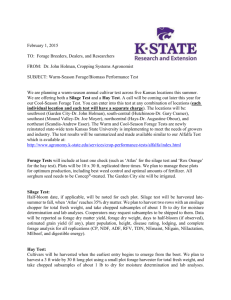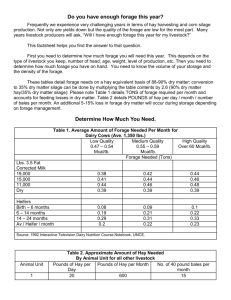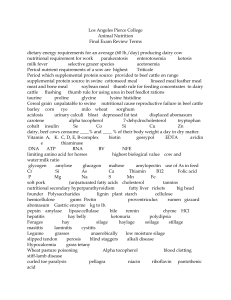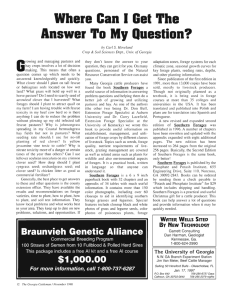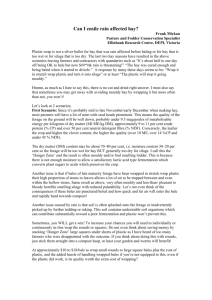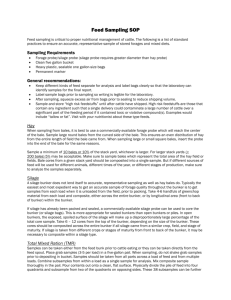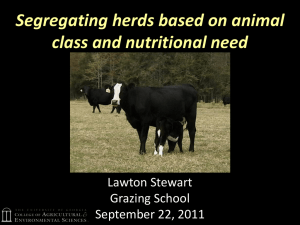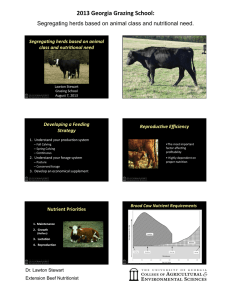Feed and Forage Sampling and Analysis
advertisement
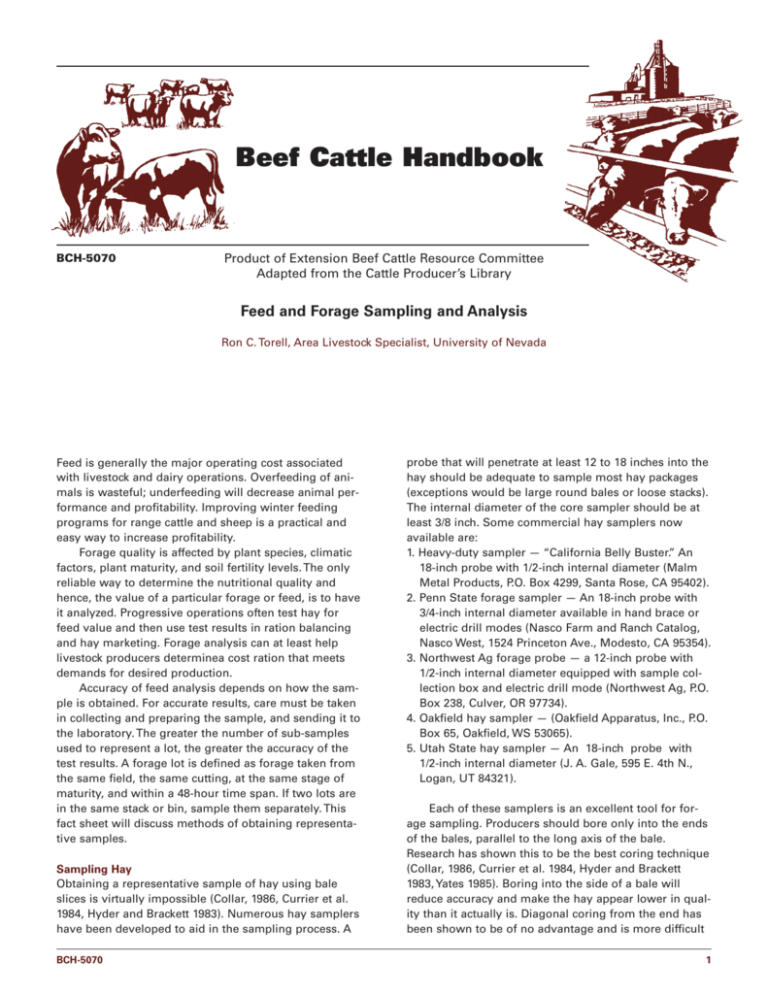
Beef Cattle Handbook BCH-5070 Product of Extension Beef Cattle Resource Committee Adapted from the Cattle Producer’s Library Feed and Forage Sampling and Analysis Ron C. Torell, Area Livestock Specialist, University of Nevada Feed is generally the major operating cost associated with livestock and dairy operations. Overfeeding of animals is wasteful; underfeeding will decrease animal performance and profitability. Improving winter feeding programs for range cattle and sheep is a practical and easy way to increase profitability. Forage quality is affected by plant species, climatic factors, plant maturity, and soil fertility levels. The only reliable way to determine the nutritional quality and hence, the value of a particular forage or feed, is to have it analyzed. Progressive operations often test hay for feed value and then use test results in ration balancing and hay marketing. Forage analysis can at least help livestock producers determinea cost ration that meets demands for desired production. Accuracy of feed analysis depends on how the sample is obtained. For accurate results, care must be taken in collecting and preparing the sample, and sending it to the laboratory. The greater the number of sub-samples used to represent a lot, the greater the accuracy of the test results. A forage lot is defined as forage taken from the same field, the same cutting, at the same stage of maturity, and within a 48-hour time span. If two lots are in the same stack or bin, sample them separately. This fact sheet will discuss methods of obtaining representative samples. Sampling Hay Obtaining a representative sample of hay using bale slices is virtually impossible (Collar, 1986, Currier et al. 1984, Hyder and Brackett 1983). Numerous hay samplers have been developed to aid in the sampling process. A BCH-5070 probe that will penetrate at least 12 to 18 inches into the hay should be adequate to sample most hay packages (exceptions would be large round bales or loose stacks). The internal diameter of the core sampler should be at least 3/8 inch. Some commercial hay samplers now available are: 1. Heavy-duty sampler — “California Belly Buster.” An 18-inch probe with 1/2-inch internal diameter (Malm Metal Products, P.O. Box 4299, Santa Rose, CA 95402). 2. Penn State forage sampler — An 18-inch probe with 3/4-inch internal diameter available in hand brace or electric drill modes (Nasco Farm and Ranch Catalog, Nasco West, 1524 Princeton Ave., Modesto, CA 95354). 3. Northwest Ag forage probe — a 12-inch probe with 1/2-inch internal diameter equipped with sample collection box and electric drill mode (Northwest Ag, P.O. Box 238, Culver, OR 97734). 4. Oakfield hay sampler — (Oakfield Apparatus, Inc., P.O. Box 65, Oakfield, WS 53065). 5. Utah State hay sampler — An 18-inch probe with 1/2-inch internal diameter (J. A. Gale, 595 E. 4th N., Logan, UT 84321). Each of these samplers is an excellent tool for forage sampling. Producers should bore only into the ends of the bales, parallel to the long axis of the bale. Research has shown this to be the best coring technique (Collar, 1986, Currier et al. 1984, Hyder and Brackett 1983, Yates 1985). Boring into the side of a bale will reduce accuracy and make the hay appear lower in quality than it actually is. Diagonal coring from the end has been shown to be of no advantage and is more difficult 1 for the person doing the sampling. Bore a minimum of 20 cores to the full depth of the probe for each 80 to 100 tons of hay being sampled. Fewer cores decrease the reliability of the analysis. Finally, the sample should not be divided. Stems and leaves will separate and settle in the sample. A good sample may be ruined by dividing it. The entire sample should be placed in a polyethylene freezer bag, sealed tightly, and labeled. This will allow the laboratory to report a dry matter “as received,” which will approximate the dry matter content of the lot of hay when sampled. Sampling Silage, High-Moisture Grain, Haylage, and Fresh Forage Silage, high-moisture grain, and haylage can be accurately sampled at harvest if moisture content is low enough to prevent seepage. If seepage is expected, wait until seepage has stopped before sampling, or, take samples as it is being fed. Collect silage in a large plastic bucket or container from several representative loads by taking random handfuls. Mix silage thoroughly, and fill a plastic sample bag from this composite. Seal and identify the sample, and send it immediately to the laboratory for analysis. You may also freeze the sample to prevent decomposition until you are ready to send the sample for analysis. High-moisture samples should not be exposed to elevated temperatures, as a “browning reaction” will occur and the nutrient quality of the sample will decline. If samples are taken after ensiling, secure random handfuls of silage from at least 10 different locations over the exposed surface area of the silage. If samples are taken as silage is being unloaded, allow the unloader to make one or more revolutions before selecting random handfuls for composite sample. Range Pasture Sampling The number of samples needed to obtain a representative sample of range or pasture will depend on the uniformity of species present, soil types, and topography. A pasture or range with similar plant species, soils, and topography can be adequately sampled by clipping four plots, each 1-foot square, in five randomly selected areas of the pasture. The producer should randomly select Plot 1, clip all the forage in the foot-square frame approximately 1 inch above the soil surface, then select Plot 2. Clip this plot and proceed as before until four plots in a general area have been clipped. Then move to other representative areas in the pasture and repeat the clipping procedure until a minimum four plots in each of five areas have been clipped. A total of 20 plots are clipped. In pastures or ranges that are more diverse, more areas will need to be represented in the sample. The forage from all clipped plots should be thoroughly mixed in a clean container. The entire sample should be sent to the laboratory for analysis. With good insulation, the sample will arrive in a cool condition with a minimum of deterioration. This method provides a good indication of the nutritional value of the entire pasture, but it does not take 2 into account an animal’s selective feeding behavior. Note also that using this sampling procedure to determine potential mineral status in the animal can be misleading. If detailed nutritional information is needed, an alternative method should be considered. Fresh fecal samples should be collected so that species composition of diets can be determined. It is best to collect five composite fecal samples (a composite sample should contain 5 to 10 individual defecations) for microhistological analysis. At the same time, a forage sample of the major plant species in the area should be obtained so the nutritional quality of individual forage species can be analyzed. Table 1 is an example of how this sampling information can be used. To obtain a good estimate, information is needed for more than 80 percent of the forage species consumed by the animals. Generally, 10 to 15 of the available forages in an area account for more than 80 percent of the diet. Sampling Concentrate and Pelleted Feeds Using a grain probe is the most convenient and accurate way to obtain concentrate samples from bins or trucks. A minimum of five samples should be taken and mixed thoroughly in a clean container. If a grain probe is not available, six handfuls of the concentrate should be removed from the bin or truck at random locations. If the concentrates are in sacks, a double-handful sample from each of three or four sacks should be combined. A pint of this mix should be adequate for analysis. The minimum nutrient analysis of commercially produced concentrate feeds is listed on the feed label. Collecting your own sample and getting a nutrient analysis will confirm the quality of the product. When sampling pelleted or cubed feeds, several cubes or handfuls of pellets should be selected from 15 to 20 locations for each “lot” so that a minimum of 40 cubes or 1 pound of pellets is selected. Each lot should be limited to 200 tons or less. Table 1. Estimated Crude Protein in Diets Consumed by Livestock. Weighed Forage % forage Nutritive value estimate 2 species in diet1 of forage species of quality A 50 x 8.0 = 400.0 B 20 x 7.0 = 140.0 C 15 x 8.5 = 127.5 D 10 x 4.0 = 40.0 95 705.5 These values are from laboratory analysis of fecal samples. These values are from the laboratory analysis of clipped forage species. 705.5 ÷ 95 = 7.4% crude protein level in the diet. 1 2 Beef Cattle Handbook Nutrient Analysis used to rank feeds in order of their net energy content. Energy The primary source of energy in feed is carbohydrates. Carbohydrates include sugar, starch, cellulose, and hemicellulose. The cellulose and hemicellulose are contained in plant cell walls in a complex with lignin, an indigestible compound. The sugar and starches are found in the cell solubles (VanSoest 1975 and 1982). The cell walls are the lowest in digestibility, and cell solubles the highest. Thus, the higher the proportion of cell walls, the lower the total digestible nutrients (TDN) or net energy value of the feed. Crude Fiber and Nitrogen-free Extract System Crude fiber and nitrogen-free extract has been the standard analysis for fibrous parts of the plant. This method of analysis dates back to 1864 and is still being used. However, considerable research has shown the crude fiber/nitrogen-free extract (NFE) system fails to make a clear distinction between less digestible and readily digestible materials. Therefore, crude fiber estimates should only serve as a rough guide to differences in the fiber content of feeds. Nitrogen-free extract represents the energy of the highly digestible cell soluble, or sugars and starches. Total digestible nutrient represents the proportion of the energy sources — fiber, protein, sugars, starches, and fat — that are digestible. TDN can be calculated by determining the moisture, crude fiber NFE, protein, fat, and minerals in the feed, multiplying each item by its digestibility, and adding up the percentages. Usually, average digestibilities from many experiments are used. The fat value is multiplied by 2.25 in the calculations to adjust for its higher energy value. Table 2 is an example of how TDN is calculated. For this example, TDN is 77.08 percent. Since the feed contains 10 percent moisture (or is 90 percent dry matter), the TDN content of the dry matter is 85.7 percent. That’s 77.08 ÷ 0.9. Table 2. An Example of Calculating TDN in a Ration. % in Average % of digestible Component feed digestibility components of feed Water Crude fiber Ether extract (fat) Protein Minerals NFE 10 10 50 3 10 2 65 90 75 90 Total 100 50 x .10 = 5.00 3 x .90 x 2.25 = 6.08 10 x .75 = 7.50 65 x .90 = 58.50 77.08 If you have a total feed analysis of a feed sample, the estimated TDN value would be calculated in this manner. Because of the errors in this system, it is only an estimate of the energy content. Feeds high in TDN will also be high in net energy, however. TDN values can be BCH-5070 Acid Detergent Fiber System Acid detergent fiber analysis will accurately measure the amount of poorly digestible cell wall components, primarily lignin. Formulas are under development that can be used to estimate net energy content of a feed from an analysis for ADF (VanSoest 1975 and 1982). The ADF values are then used in equations to determine TDN. The TDN system is appealing because one can determine the ADF composition of a feed and multiply published average digestion coefficients by each component to arrive at the percentage TDN in the feed. Table 3 shows an example of this procedure and the various equations used. There is some danger in this. Average digestion coefficients may not always apply to the particular feed being fed. The biggest problem with TDN, however, is that it does not account for additional energy losses, particularly heat increment and, to some extent, gaseous losses. For this reason, TDN does not accurately estimate the energy value of feeds, particularly with ruminants where there is wide variation in the heat increment between roughage and concentrates. This same criticism applies to digestible and metabolizable energy. For this reason considerable effort has gone into developing a net energy system for use when balancing diets for ruminants. Table 3. Equations to Estimate Total Digestible Nutrient (TDN) from Various Chemical Constituents of Alfalfa Hay (100% Dry Matter Basis).1 Formula Origin Equation % TDN2 National Acid Detergent Fiber3,4 DE/.04409 = 62.24 California/Nevada Acid Detergent Fiber 78.2 - .657 ADF% = 57.83 1Alfalfa hay analysis: 100% dry matter (DM); 31% acid detergent fiber (ADF); 20% crude protein (CP). 2Calculated percent TDN. 3Percent digestible dry matter (DDM) = 88.9 - .779 (%ADF) or 88.9 - .779 (31) = 64.751% DDM Digestible energy = 0428(DDM%) - .027 or .0428(64.751) - 0.27 = 2.744 Mcal/kg Percent TDN = DE ÷ .04409 or 2.744 ÷ .04409 = 62.24% 4This type (equation) is used in estimating percent TDN from Near Infra-Red (NIR) analysis. Protein The crude total protein content of a feed sample can be accurately determined by laboratory analysis. The measured amount of nitrogen in the feed is converted to protein by multiplying by 6.25. The basis for this is that protein contains 16 percent nitrogen, or 1 part nitrogen to 6.25 parts protein. Thus, if a shelled corn sample had 1.61 percent nitrogen in the dry matter, it would be estimated to have 1.61 x 6.25 or 10.06 percent total protein. 3 The use of this procedure also results in an estimate of the amount of protein that can be synthesized in the rumen of cattle from the ammonia or urea in a feed, such as in treated silage. The amount of protein loss varies with the feedstuff. Losses are higher in fermented feed than in dry feeds because of changes that occur in the structure of protein during fermentation. Therefore, a ration based on corn silage with 8 percent total protein will need more total energy content than a ration containing grain and hay. Protein sources in supplements such as urea and other NPN products will also have higher losses than protein from natural sources because the rate at which these products are normally broken down to ammonia in the rumen exceeds the rate at which the rumen bacteria can incorporate the ammonia into protein (Petersen and Hixon 1985). Despite these quality variations, analysis for total protein is important because protein is the most expensive nutrient and because the protein content of corn and corn silage may be inadequate to meet the needs of growing and finishing cattle. Because of the substantial variation in protein content of corn silage, we add a 10 to 20 percent safety factor in our protein recommendations. If accurate nutrient values are obtained by feed analysis, the safety factor can be reduced. Even though analysis does not give us the usable protein, it does tell us whether our silage is 4.4 or 10.8 percent protein. corn silage, which is usually high in carotene content. Further, the cost of providing supplemental vitamin A is minimal. References 1. Collars, L. S. 1986. “Hay Sampling and Testing using NIRS at Dairyman’s.” In: Sixteenth California Alfalfa Symposium, Univ. of California Coop. Ext. 2. Currier, C. G., B. A. Melton, J. S. Arledge, and V. L. Marble. 1984. “Sampling Alfalfa Hay.” In: Proceedings of National Alfalfa Hay Quality Yesting Workshop. Chicago, IL. 3. Hyder, L., and S. Brackett. 1983. “An Evaluation of Hay Sampling Methods.” In: Proceedings, ninth annual Oregon Hay Growers Assn. Hay and Forage Conference, Corvallis, OR. 4. Petersen, M. K., and D. L. Hixon. 1985. “Crude protein isn’t just protein.” Cattlemen’s Library. 5. Van Soest, P. J. 1975. “Physio-chemical aspects of fiber digestion.” In: F. W. McDonald and ACI Warner (eds.). Digestion and metabolism in the ruminant. The Univ. New England Publ. Unit, Armidale, Australia. 6. Van Soest, P. J. 1982. “Nutritional ecology of the ruminant”. O & B Books, Inc., Corvallis, OR. 7. Yates, D. A. 1985. “Feed and Forage Sampling Procedures.” Cattlemen’s Library. Minerals Accurate methods are available for mineral analysis. These are valuable since most rations need supplemental minerals. Most high forage rations are deficient in phosphorus, and supplemental phosphorus may be needed. Vitamins The only vitamins normally of concern are A, and sometimes, E. Vitamin A content can be determined through an analysis for carotene content, as cattle convert carotene to vitamin A. This is not of great concern, however, because typical management practices provide adequate quantities of vitamin A. New feeder cattle are usually injected with 1 to 2 million I.U. of vitamin A to aid in combatting stress. Also, many rations are high in Author: Ron C. Torell, Area Livestock Specialist, University of Nevada Adapted from the Cattle Producer’s Library This publication was prepared in cooperation with the Extension Beef Cattle Resource Committee and its member states and produced in an electronic format by the University of Wisconsin-Extension, Cooperative Extension. Issued in furtherance of Cooperative Extension work, ACTS of May 8 and June 30, 1914. BCH-5070 Feed and Forage Sampling and Analysis 4 Beef Cattle Handbook
